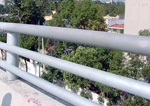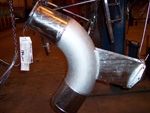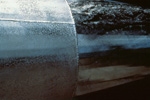Why is steel chemistry important in the hot-dip galvanizing process?
Galvanized coatings are formed by a chemical process during which steel and zinc metallurgically bond, forming a series of corrosion-inhibiting, highly abrasion-resistant zinc/iron alloy layers.
Galvanized coatings are specified for their corrosion resistance. While a gray or matte appearance may occur, the corrosion protection afforded is no different than that provided by shinier galvanized coatings. The corrosion resistance of matte coatings, mil for mil, is equal to the more typical bright, shiny galvanized coating.

When possible, the galvanizer should be advised of the grade of steel selected in order to determine whether to make accommodations in the galvanizing process. Though most ferrous materials can be hot-dip galvanized, the chemical composition of the material affects the characteristics of the galvanized coating.
Steel compositions vary depending on strength and service requirements. Trace elements in the steel, such as silicon and phosphorus, affect the galvanizing process as well as the structure and appearance of the galvanized coating. For example, certain elements present in the steel may result in a coating composed almost entirely of zinc-iron alloy layers with little or no free zinc layer.

The chemistry of the steel being galvanized influences the galvanized coatings appearance. Galvanized coatings on steels with common chemistries are typically shinier than are coatings on reactive steels, which tend to produce matte gray coatings.
Additionally, high-strength steel chemistries for steels with ultimate tensile strength of 150 ksi (1100 MPa) or more may experience hydrogen embrittlement of the steel. Galvanized coatings are specified for their corrosion resistance. While a gray or matte appearance may occur, the corrosion protection afforded is no different than that provided by shinier galvanized coatings. The corrosion resistance of matte coatings, mil for mil, is equal to the more typical bright, shiny galvanized coating.

Steel compositions vary depending on strength and service requirements. Trace elements in the steel, such as silicon and phosphorus, affect the galvanizing process as well as the structure and appearance of the galvanized coating. For example, certain elements present in the steel may result in a coating composed almost entirely of zinc-iron alloy layers with little or no free zinc layer.
Related article - Evaluating Steel Chemistry Prior to Galvanizing
© 2025 American Galvanizers Association. The material provided herein has been developed to provide accurate and authoritative information about after-fabrication hot-dip galvanized steel. This material provides general information only and is not intended as a substitute for competent professional examination and verification as to suitability and applicability. The information provided herein is not intended as a representation or warranty on the part of the AGA. Anyone making use of this information assumes all liability arising from such use.

